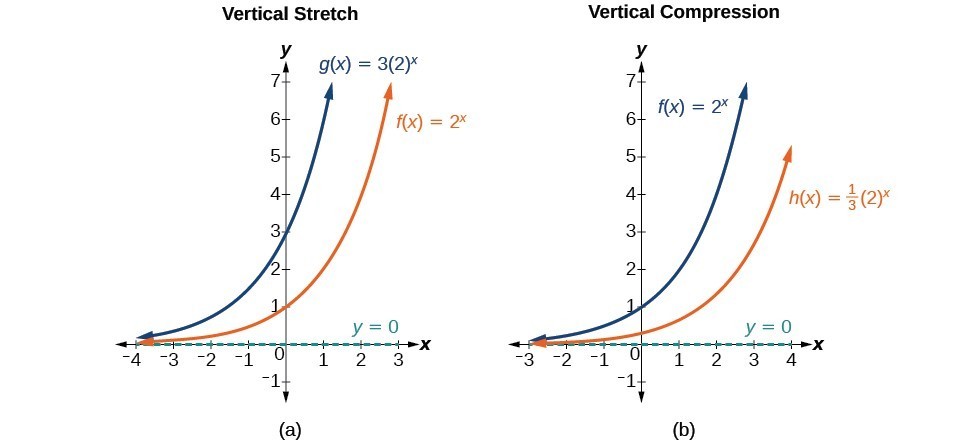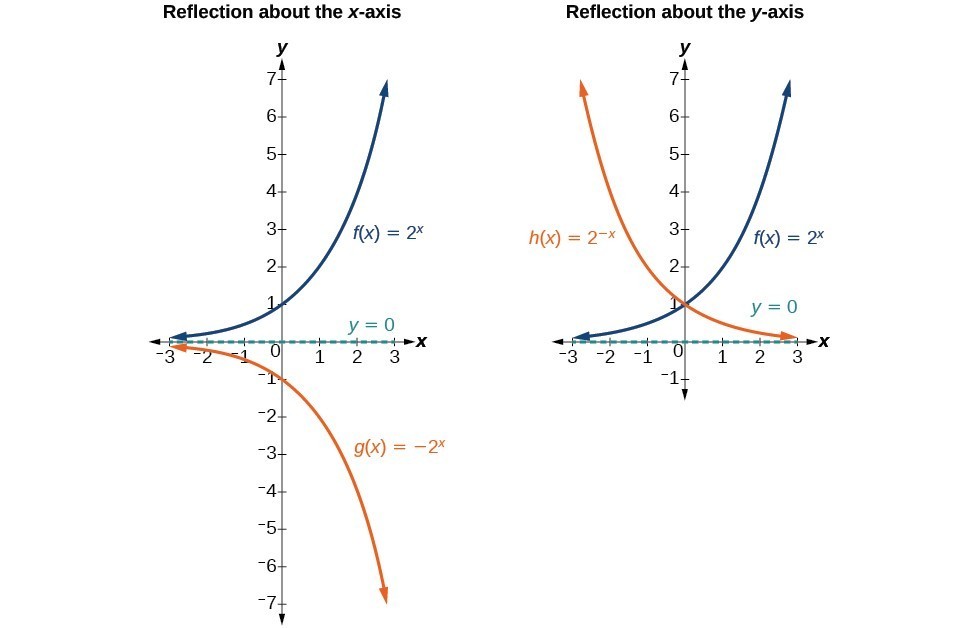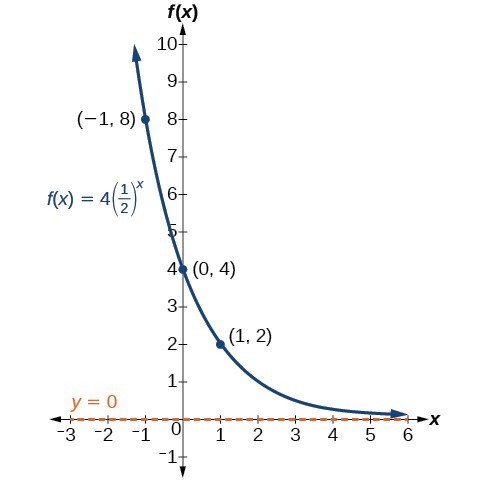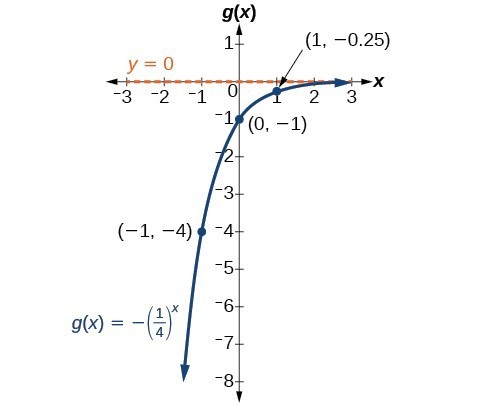Learning Objectives
- Graph a stretched or compressed exponential function
- Graph a reflected exponential function
- Write the equation of an exponential function that has been transformed
While horizontal and vertical shifts involve adding constants to the input or to the function itself, a stretch or compression occurs when we multiply the parent function [latex]f\left(x\right)={b}^{x}[/latex] by a constant [latex]|a|>0[/latex]. For example, if we begin by graphing the parent function [latex]f\left(x\right)={2}^{x}[/latex], we can then graph the stretch, using [latex]a=3[/latex], to get [latex]g\left(x\right)=3{\left(2\right)}^{x}[/latex] as shown on the left in Figure 8, and the compression, using [latex]a=\frac{1}{3}[/latex], to get [latex]h\left(x\right)=\frac{1}{3}{\left(2\right)}^{x}[/latex] as shown on the right in the figure below.

(a) [latex]g\left(x\right)=3{\left(2\right)}^{x}[/latex] stretches the graph of [latex]f\left(x\right)={2}^{x}[/latex] vertically by a factor of 3. (b) [latex]h\left(x\right)=\frac{1}{3}{\left(2\right)}^{x}[/latex] compresses the graph of [latex]f\left(x\right)={2}^{x}[/latex] vertically by a factor of [latex]\frac{1}{3}[/latex].
A General Note: Stretches and Compressions of the Parent Function f(x) = bx
For any factor a > 0, the function [latex]f\left(x\right)=a{\left(b\right)}^{x}[/latex]
- is stretched vertically by a factor of a if [latex]|a|>1[/latex].
- is compressed vertically by a factor of a if [latex]|a|<1[/latex].
- has a y-intercept of [latex]\left(0,a\right)[/latex].
- has a horizontal asymptote at [latex]y=0[/latex], a range of [latex]\left(0,\infty \right)[/latex], and a domain of [latex]\left(-\infty ,\infty \right)[/latex], which are unchanged from the parent function.
Example: Graphing the Stretch of an Exponential Function
Sketch a graph of [latex]f\left(x\right)=4{\left(\frac{1}{2}\right)}^{x}[/latex]. State the domain, range, and asymptote.
Try It
Use the sliders in the graph below to sketch the graph of [latex]f\left(x\right)=\frac{1}{2}{\left(4\right)}^{x}[/latex]. State the domain, range, and asymptote.
https://www.desmos.com/calculator/u8kysdu1wl
Graphing Reflections
In addition to shifting, compressing, and stretching a graph, we can also reflect it about the x-axis or the y-axis. When we multiply the parent function [latex]f\left(x\right)={b}^{x}[/latex] by –1, we get a reflection about the x-axis. When we multiply the input by –1, we get a reflection about the y-axis. For example, if we begin by graphing the parent function [latex]f\left(x\right)={2}^{x}[/latex], we can then graph the two reflections alongside it. The reflection about the x-axis, [latex]g\left(x\right)={-2}^{x}[/latex], is shown on the left side, and the reflection about the y-axis [latex]h\left(x\right)={2}^{-x}[/latex], is shown on the right side.

(a) [latex]g\left(x\right)=-{2}^{x}[/latex] reflects the graph of [latex]f\left(x\right)={2}^{x}[/latex] about the x-axis. (b) [latex]g\left(x\right)={2}^{-x}[/latex] reflects the graph of [latex]f\left(x\right)={2}^{x}[/latex] about the y-axis.
A General Note: Reflections of the Parent Function f(x) = bx
The function [latex]f\left(x\right)=-{b}^{x}[/latex]
- reflects the parent function [latex]f\left(x\right)={b}^{x}[/latex] about the x-axis.
- has a y-intercept of [latex]\left(0,-1\right)[/latex].
- has a range of [latex]\left(-\infty ,0\right)[/latex]
- has a horizontal asymptote at [latex]y=0[/latex] and domain of [latex]\left(-\infty ,\infty \right)[/latex], which are unchanged from the parent function.
The function [latex]f\left(x\right)={b}^{-x}[/latex]
- reflects the parent function [latex]f\left(x\right)={b}^{x}[/latex] about the y-axis.
- has a y-intercept of [latex]\left(0,1\right)[/latex], a horizontal asymptote at [latex]y=0[/latex], a range of [latex]\left(0,\infty \right)[/latex], and a domain of [latex]\left(-\infty ,\infty \right)[/latex], which are unchanged from the parent function.
Example: Writing and Graphing the Reflection of an Exponential Function
Find and graph the equation for a function, [latex]g\left(x\right)[/latex], that reflects [latex]f\left(x\right)={\left(\frac{1}{4}\right)}^{x}[/latex] about the x-axis. State its domain, range, and asymptote.
Try It
Use Desmos to graph the equation for a function, [latex]g\left(x\right)[/latex], that reflects [latex]f\left(x\right)={1.25}^{x}[/latex] about the y-axis. State its domain, range, and asymptote.
Summarizing Translations of the Exponential Function
Now that we have worked with each type of translation for the exponential function, we can summarize them to arrive at the general equation for translating exponential functions.
| Translations of the Parent Function [latex]f\left(x\right)={b}^{x}[/latex] | |
|---|---|
| Translation | Form |
Shift
|
[latex]f\left(x\right)={b}^{x+c}+d[/latex] |
Stretch and Compress
|
[latex]f\left(x\right)=a{b}^{x}[/latex] |
| Reflect about the x-axis | [latex]f\left(x\right)=-{b}^{x}[/latex] |
| Reflect about the y-axis | [latex]f\left(x\right)={b}^{-x}={\left(\frac{1}{b}\right)}^{x}[/latex] |
| General equation for all translations | [latex]f\left(x\right)=a{b}^{x+c}+d[/latex] |
A General Note: Translations of Exponential Functions
A translation of an exponential function has the form
[latex] f\left(x\right)=a{b}^{x+c}+d[/latex]
Where the parent function, [latex]y={b}^{x}[/latex], [latex]b>1[/latex], is
- shifted horizontally c units to the left.
- stretched vertically by a factor of |a| if |a| > 0.
- compressed vertically by a factor of |a| if 0 < |a| < 1.
- shifted vertically d units.
- reflected about the x-axis when a < 0.
Note the order of the shifts, transformations, and reflections follow the order of operations.
Example: Writing a Function from a Description
Write the equation for the function described below. Give the horizontal asymptote, the domain, and the range.
- [latex]f\left(x\right)={e}^{x}[/latex] is vertically stretched by a factor of 2, reflected across the y-axis, and then shifted up 4 units.
Try It
Write the equation for function described below. Give the horizontal asymptote, the domain, and the range.
- [latex]f\left(x\right)={e}^{x}[/latex] is compressed vertically by a factor of [latex]\frac{1}{3}[/latex], reflected across the x-axis and then shifted down 2 units.



